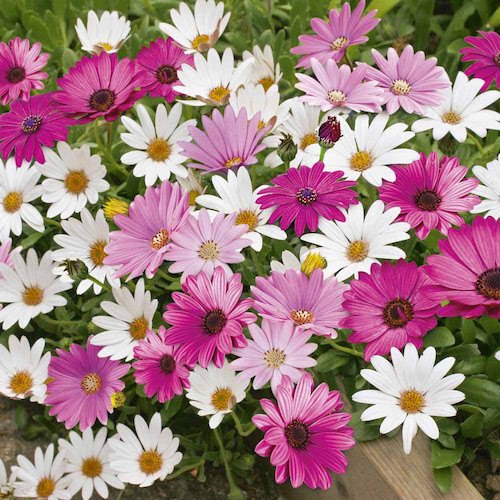With Horticulturist Gareth Austin
All the baskets, window boxes are out…at long last! Yours, like mines, were probably later to get put out, the cold winds and coolish weather has put annual displays back around 3 weeks in most cases. And now they’re up we’re needing to start taking good care of them, to really get the motoring and performing.
In previous weeks we talked through how to plant a hanging basket (if you missed it go to the top right of this page and in the search box type in Gareth Austin and all the previous posts will come up ☺) , so this week is a kind-off continuation of that and in general how to get the most from your bedding plants.
Lifecycles
Bedding plants are for the greater part Annuals. Flowering Plants are divided into 3 main groups, Annuals, Biennials and Perennials. Annuals are plants which germinate from seed, put on foliage growth, flower and then set seed in a single growing season, Biennials do this process over 2 seasons, in the first season they germinate from seed, put on foliage growth and then in the second season they flower and set seed. Perennials in season 1 germinate from seed and then (mostly) flower in their second season and last for more than 2 years.
As the vast majority of our bedding plants are annuals it’s important that we repeatedly dead-head them, this prevents them from producing seed, which will then bring them to the end of their lifespan, so regular dead-heading, on a weekly basis is essential to encourage the plant to produce more flowers, Joe Whelan from Rathmullan House says that they at least once a week week dead from July through September.
Watering
Stress from a lack of water, or from over watering will encourage the plant to run through the flowering process quickly, and in turn producing seeds. This ‘bolting’ is an all too common affair in dry hanging baskets and in over watered pots. Volume of water will depend on the type of compost, use of water storing granules and the likes, in a pot use your finger as a guide, if you push it in and the compost feels moist then don’t water (likewise if its dry then water them), whereas for hanging baskets these will need watered every day. If it suits, then try to install a water bottle or such to your pots to allow for slower water release. Large volumes of water applied to hanging baskets will cause leaching of nutrients (this is where the available fertiliser in the compost runs down through and out the bottom of the basket), so the more you water the more you will have to feed. Consider feeding every third watering.
Feeding
Again dependant on how much fertility you incorporated into the potting mix this will affect how much you have to feed the plants (and in turn how much water is retained in the planting area). If you’ve used the slow release fertilisers and the likes then you’ll probably only have to liquid feed once or twice in a season (to give them a boost), otherwise your feeding should be on a fortnightly basis. Overfeeding will encourage leggyness in your bedding and in your baskets. This leggyness comes about due to the Nitrogen part of the fertiliser being absorbed and uptaken faster than the other nutrients (the Phosphorus and the Potassium), so when you use Tomato Feed or another Hanging Basket feed only use them every fortnight to allow for all the minerals to work, before you top them up again. Head Gardener of Rathmullan House Joe Whelan said that in Rathmullan they feed once a week with a high potassium and phosphorus feed (tomato feed, miracle grow) from July onwards to maintain the fabulous baskets and displays around the Hotel. Rathmullan House is one of the many fine gardens that help to make up the Donegal Garden Trail. Many people don’t realise you can just walk in to Rathmullan House and visit the gardens, so next time your in the area call in, look at the walled kitchen garden…its fab!
What to feed them
Liquid tomato feed is ideal as a ‘booster’ to encourage flowers on the plants, also seaweed fertiliser and homemade comfrey juice are ideal. Important thing here is the potting mix and use of a slow-release or controlled release fertiliser at the time of planting, by doing this you’ll have to apply less fertiliser and in turn will give yourself less watering.
Slug and Snails
Tricky one this. There is a mountain of suggestions out there on what to use for this. Here’s a few: Reduce watering in the evening, if you water flower beds or pots in the evening then you’re creating an ideal escalator system for slugs to scoot about on, whereas if you water in the morning the ground dries up before the evening making it more difficult for the slugs and snails to get about. Slug Pellets, firstly with the inorganic pellets, the secret here is to use little and often – use 6 slug pellets to the m2 applied every fortnight. Yes, 6 slug pellets…not 6 handfulls…no more blue snow!! The blue part of the pellet is the attractant part, this encourages the slugs to eat the poison (which is the wee black specs), the attractant wears off after a week or so, so blue snow is 2 weeks has no interest to the slugs…meaning not only is this blue snow affect unsightly, but its also wasting you money and possibly causing concern to wildlife and kids – who’s naturally inquisitive minds see all these blue snow rings and want to pick them up. Organic slug pellets are made from Iron Phosphate and this repels slugs, so you sprinkle these far more liberally than the inorganic works and will need to repeat them regularly… (We’re gonna do a special on Slug and Snail Control next week)
Remember the gardens of Rathmullan House is part of the Donegal Garden Trail, have a look at the many great gardens open this year by visiting their website www.donegalgardentrail.com
Plant of the week:
Lupins. These at the minute are spectacular and are somewhat fashionable at the moment, they were featured in nearly every show garden at this years Bloom Garden Festival. Their striking spikes of flowers are in full colour now and enlighten any garden. Easy to grow from seed and they’re great value as a ready-to-go garden plant, with garden centres offering super selection of colours. If you’ve no Lupins in your garden….then get some!
Next Week, Slug and Snail Special…the who, the what…the where of managing the No.1 garden pest!
Gareth Austin is resident Horticulturist with BBC Radio Foyle, a member of the Chartered Institute of Horticulturists and lectures in Horticulture with National Learning Network. For more see www.garethaustin.com or join Gareth on Twitter @GardenerGareth .










